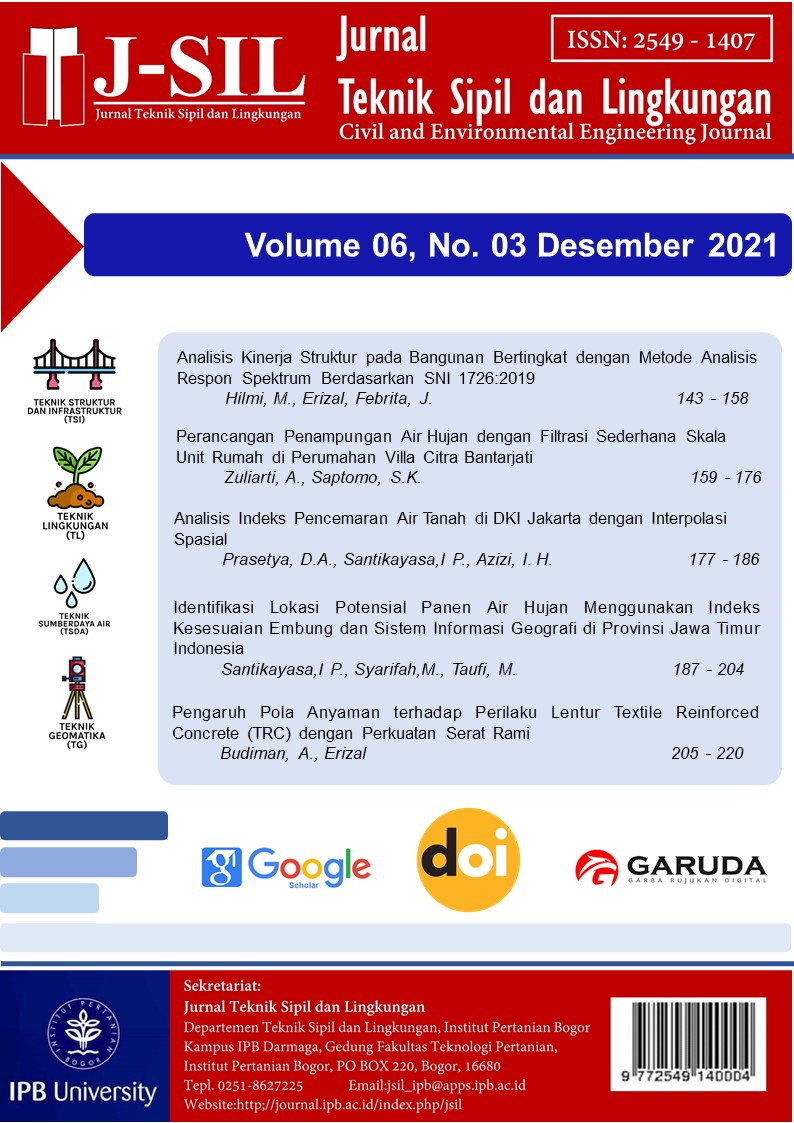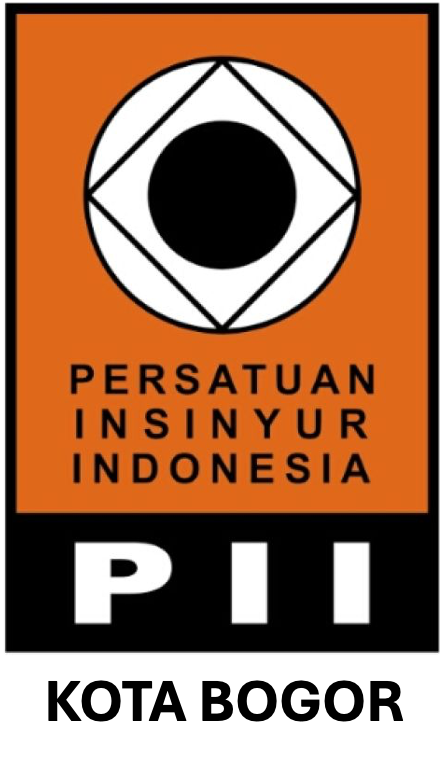Pengaruh Pola Anyaman terhadap Perilaku Lentur Textile Reinforced Concrete (TRC) dengan Perkuatan Serat Rami
The Effect of Woven Patterns on Flexural Behaviour of Textile Reinforced Concrete (TRC) with Ramie Fiber Reinforcement
Abstract
The demand of concrete has increased in Indonesia. A reinforced concrete innovation being developed is Textile Reinforced Concrete (TRC). Ramie fiber has great potential to be used as a construction material because it has advantages over other natural fibers, such as tensile strength properties. The research aims to analyzed flexural behaviour of Ramie fiber TRC. This research was conducted from February until June 2021 at IPB University. The research was carried out through several stages, that are testing of TRC materials, mix design, weaving and coating ramie fiber, manufacturing and curing test objects, and testing. The flexural behavior analyzed flexural strength, stiffness, ductility, and crack behavior. Ramie fiber reinforcement can improve the elasticity and ductility of mortar plates. However, woven ramie fiber with a certain woven pattern can reduce flexural strength. Coating ramie fiber with Unsaturated Polyester Resin (UPR) provides an increase in flexural strength, elastic properties, and ductility. Phases of crack behaviour of UPR-coated are uncracked, crack formation, crack stabilization, and failure. The woven pattern that produces the highest flexural strength is the two-axis woven pattern for UPR-coated ramie, which is 7.84 MPa.
Downloads
References
Alamsyah FT, Stefanus AK, Santosa B. 2017. Pengembangan Textile Reinforced Concrete (TRC) slab menggunakan serat cantula dengan berbagai anyaman. E-Jurnal Matriks Teknik Sipil. 5(4): 1362–1369.
[ASTM] American Standard Testing and Material. 2003. Standard Test Method for Flexural Properties of Thin-Section Glass-Fiber-Reinforced Concrete (Using Simple Beam with Third-Point Loading). ASTM C947-03. Pennsylvania (US): ASTM International.
Brameshuber W. 2006. Textile Reinforced Concrete. Bagneux (FR): RILEM Publications.
Colombo I, Magri A, Zani G. 2013. Erratum to: Textile Reinforced Concrete: experimental investigation on design parameters. Mater Struct. 46: 195 –1971.
[EFNARC] European Federation of National Associations Representing for Concrete. 2005. The European Guidelines for Self Compacting Concrete. EFNARC 2005.
Fajri RI, Tarkono, Sugiyanto. 2013. Studi sifat mekanik komposit serat Sansevieria cylindrica dengan variasi fraksi volume bermatrik polyester. Jurnal FEMA. 1(2): 85–93.
Gayathri CN, Singh RB, Dhanalakshmi G. 2018. Mechanical behavior of textile reinforced concrete. IRJET. 5(5): 2227-2231.
Kadir A. Aminur. Marzan. 2014. Pengaruh pola anyaman terhadap kekuatan tarik dan bending komposit berpenguat bambu. Jurnal Ilmiah Teknik Mesin. 6(1): 9–18.
Lorenz E, Schütze E, Schladitz F, Curbach M. 2013. Textilbeton–grundlegende untersuchungen im überblick. Beton und Stahlbetonbau. 108 (10): 711–722.
Mechtcherine V. 2013. Novel cement-based composites for the strengthening and repair of concrete structures. Construction Building Material. 41:365–373.
Mueller DH, Krobjilowski A. 2003. New Discovery in the Sifates of Composites Reinforced with Natural Fibers. Journal of Industrial Textile. 33(2):111–130.
Naidu AL, Jagadeesh V, Bahubalendruni MVAR. 2017. A review on chemical and physical properties of natural fiber reinforced composites. International Journal of Advanced Research in Engineering and Technology. 8(1): 56–68.
Nurlina S, Suseno H, Hidayat MT, Pratama IMY. 2016. Perbandingan daktilitas balok beton bertulang dengan menggunakan perkuatan CFRP dan GFRP. Rekayasa Sipil. 10(1): 62–69.
Portal NW. 2013. Sustainability and flexural behavior of textile reinforced concrete [Tesis]. Gothenburg (SE): Chalmer University of Technology.
Purwanto E, Kristiawan SA, Prabaswara D. 2020. Pengaruh variasi anyaman lateral seratcantula (Agave cantula roxb) pada Textile Reinforced Concrete (TRC) terhadap kuat tekan beton. E-Jurnal Matriks Teknik Sipil. 5(4): 15–21.
Rahardjo T. 2008. Study eksperimental pemanfaatan serat rami (Boehmeria nivea) sebagai bahan penguat komposit polimer matrik polisterin. Jurnal Flywheel. 1(1): 27–33.
Ujianto M. 2006. Lendutan dan kekakuan beton bertulang dengan lubang segi empat di badan. Jurnal Eco Rekayasa. 2(2): 52–57.
Schuh T, Gayer U. 1997. Lignocellulosic-Plastics Composites. Botucatu (BS): Unesp Publishers.
Yin S, Xu S, Li H. 2013. Improved mechanical properties of textile reinforce concrete thin plate. Journal of Wuhan University of Technology. 28: 92–98.
Wibowo NA. 2019. Designing of flow mortar design mix for Self Compacting Concrete (SCC) with FWC = 0.4. Journal of the civil engineering forum. 5(1): 39–46.
Copyright (c) 2021 J-Sil (Jurnal Teknik Sipil dan Lingkungan)

This work is licensed under a Creative Commons Attribution-NonCommercial-NoDerivatives 4.0 International License.
Authors who publish with Jurnal Teknik Sipil dan Lingkungan, JSIL agree to the following terms:
a. Authors retain copyright and grant the journal right of first publication with the work simultaneously licensed under a Creative Commons Attribution License that allows others to share the work with an acknowledgment of the work's authorship and initial publication in this journal.
b. Authors are able to enter into separate, additional contractual arrangements for the non-exclusive distribution of the journal's published version of the work (e.g., post it to an institutional repository or publish it in a book), with an acknowledgment of its initial publication in this journal.
c. Authors are permitted and encouraged to post their work online (e.g., in institutional repositories or on their website) prior to and during the submission process, as it can lead to productive exchanges, as well as earlier and greater citation of published work (See The Effect of Open Access).











